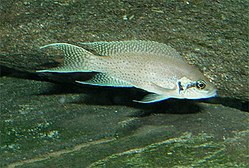Neolamprologus brichardi
| Neolamprologus brichardi | |
|---|---|

| |
| "Pemba" Race | |
| Scientific classification | |
| : | [[Template:Taxonomy/Neolamprologus]] |
| Species: | Template:Taxonomy/NeolamprologusN. brichardi
|
| Binomial name | |
| Template:Taxonomy/NeolamprologusNeolamprologus brichardi (Poll, 1974)
| |
Neolamprologus brichardi is a species of cichlid endemic to the alkaline waters of Lake Tanganyika in East Africa.[2] It is a popular aquarium fish kept in the fishkeeping hobby,[2][3] where it is known under a variety of common names including Princess cichlid, Princess of Burundi, Lyretail cichlid, Fairy cichlid and Brichard's lamprologus.[3][4][5] In addition, the species is also the subject of numerous studies on fish behaviour.[6][7][8] It is closely related to N. pulcher from the southern half of Lake Tanganyika (N. brichardi is more widespread) and some have recommended merging the two into a single species.[9]
Behaviour[edit]
N. brichardi is notable in a number of ways. This fish is a substrate spawner (lays eggs on a substrate), utilizing the rocky rubble to do so. It is one of the few substrate-spawning cichlid that also schools. It is not unheard of to find a school numbering near 100,000 individuals within a 50 metres (160 ft) square area. It is one of the few fish in Africa that utilizes a collective nursery. This means that adults, sub-adults, and even half-grown fry all participate in a multi-generational rearing of the fry. N. brichardi individuals not only care for their own fry but also the fry of those around them[citation needed], all while keeping vigil over other adults still actively spawning.[citation needed] This is similar to the cooperative breeding system of a related species of cichlid, N. pulcher, in that N. pulcher individuals will care for the offspring of others.
N. brichardi specializes in feeding from the rocky biocover, picking at small crustaceans and invertebrates. It will also feed on swarms of plankton when available.
Etymology[edit]
The specific name honours Pierre Brichard (1921-1990), an aquarium fish exporter based near Lake Tanganyika.[10]
See also[edit]
References[edit]
- ↑ Bigirimana, C. (2006). "Neolamprologus brichardi". IUCN Red List of Threatened Species. 2006: e.T60610A12383670. doi:10.2305/IUCN.UK.2006.RLTS.T60610A12383670.en. Retrieved 20 November 2021.
- ↑ 2.0 2.1 Template:FishBase
- ↑ 3.0 3.1 Riehl, Rüdiger. Editor.; Baensch, HA (1996). Aquarium Atlas (5th ed.). Germany: Tetra Press. ISBN 978-3-88244-050-8.
{{cite book}}:|first=has generic name (help) - ↑ Mills D (1993) Aquarium Fish Harper Collins ISBN 0-7322-5012-9
- ↑ Axelrod HR, Vorderwinkler W (1995) Encyclopedia of tropical fishes. 30th edition. Tropical Fish Hobbyist Publications, USA.
- ↑ Dierkesa P, Taborskya M, Kohler U (1999)Reproductive parasitism of broodcare helpers in a cooperatively breeding fish Behavioral Ecology 10: 510-515
- ↑ Balshine-Earn S, Lotem A (1998) Individual recognition in a cooperatively breeding cichlid : Evidence from video playback experiments Behaviour 135: 369-386
- ↑ Wernera NY, Balshineb S, Leachc B, Lotem A (2003) Helping opportunities and space segregation in cooperatively breeding cichlids Behavioral Ecology 6: 749-756
- ↑ Duftner; Sefc; Koblmüller; Taborsky; and Sturmbauer (2007). Parallel evolution of facial stripe patterns in the Neolamprologus brichardi/pulcher species complex endemic to Lake Tanganyika. Molecular Phylogenetics and Evolution 45: 706–715.
- ↑ Christopher Scharpf & Kenneth J. Lazara (4 December 2018). "Order CICHLIFORMES: Family CICHLIDAE: Subfamily PSEUDOCRENILABRINAE (l-o)". The ETYFish Project Fish Name Etymology Database. Christopher Scharpf and Kenneth J. Lazara. Retrieved 29 January 2019.

